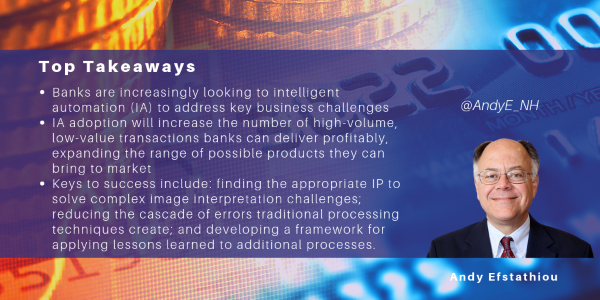Search posts by keywords:
Filter posts by author:
Related Reports
Related NEAT Reports
Other blog posts
posted on Jul 16, 2019 by Andy Efstathiou

The BFSI industries are increasingly looking to intelligent automation (IA) to address key challenges in their business. A recent NelsonHall survey of 50 BFSI executives found that they perceive that IA is able to replace manual processing and human decision-making, allowing the bank’s operations to decouple processing volumes from headcount. Key benefits respondents expect to receive from IA include:
- Improved handling of low value transactions (100% of respondents)
- Reduced cost (98%)
- Improved service fulfillment times (96%)
- Reduced error rates (92%)
- Improved customer experience (88%).
However, achieving these benefits has frequently been challenging because:
- Use cases are domain intense, allowing at most 50% reuse for similar processes
- Implementation is labor intense, often requiring 4 to 6 months of time and costing up to $1m
- Unmanaged bots can learn the wrong things and “go off the rails” over time, destroying value
- IA is not one technology, but multiple technologies working in concert, which makes effective systems coordination critical to delivering a useable solution.
The complexity of these challenges requires IA vendors to create a roadmap and deliver an offering which targets a narrow range of problems. Typically, there needs to be three types of participant in the development of an IA offering:
- Systems integrator: who will identify client needs, implement the customized solution, and manage the ongoing operation of the IA solution to assure continued effectiveness
- Academic partner: who will provide advanced cognitive technological tools and insight to develop a differentiated offering
- Product vendors: to deliver COTS RPA and basic IA tools to the offering.
Let’s look at how one vendor developed an IA offering, and then at an example of how it was deployed.
HCL’s EXACTO
HCL decided to create an IA offering in 2016, focusing their product on the processing of unstructured data. They began their process by partnering with a leading U.S.-based university, which had developed analytic solutions for processing radiology images. The image processing capability would be useful for processing physical paper documents used in banking contracts, procurement, and handwritten documents.
HCL launched its IA product, EXACTO, in 2017. The underlying platform is built on open source machine learning libraries. The product uses servers with GPUs to run Deep Neural network algorithms. EXACTO can integrate into an existing workflow application with a single API. It has four differentiating capabilities:
- Image processing: fixes distortions, removes noise, and sharpens images
- Text recognition: extracts text from heterogeneous fonts/handwriting. Detects multi-languages
- Domain ontology: provides data correction and search-and-sort fields from data streams
- Deep learning and natural language processing: extracts localized characters and classifies documents.
HCL claims EXACTO achieves 85% to 95% accuracy on typewritten documents and 60% to 65% accuracy on handwriting. It processes documents in three stages:
- Digitization of document images
- Classification of the output into categories
- Extraction of data from the digital output, which is then fed into the target application.
Let’s look at how EXACTO was applied to a very manual, paper-based processing environment.
Trade processing at a global bank
Trade processing is well known for using faxes across very large numbers of parties to conduct business, and frustrates attempts at process automation. The process has a T+1 reconciliation window, which drives increased costs as labor needs to be applied in volume to meet the deadline. Initial errors from manual processing are enhanced by errors introduced by manual processes in the audit trail. Typical errors include:
- Trades erroneously marked as processed in the source system, when they have not been entered into the target system
- Trades marked as duplicate when two similar, but different trades are received from two different brokers
- Data entry discrepancies at the time of trade booking which are not caught until reconciliation.
EXACTO was applied to the processing of faxes and paper documents. It classifies documents using a domain ontology and extracts text into a digital form which is then processed.
Benefits from the use of this IA solution include:
- Reduction in average handle time of 60%
- Enhanced accuracy due to machine learning
- Improved audit trails and compliance
- Can identify duplicates and correctly tag them
- Continuous automated evaluation and improvement of process
- Can run multiple instances to process large volumes
- Able to process 24/7, unlike humans
- Auto-capture of data without the need to configure each input template.
Summary
As described above, IA is enabling institutions to read documents and pictures faster and more accurately than humans. It is then able to process the resulting information with greater accuracy and speed. The traditional cascade of errors is mitigated, improving regulatory compliance and customer satisfaction. The key to success in this endeavor is finding the appropriate technical IP (in this case in a partnership between domain experts at HCL and image reading technology at a leading U.S.-based university) to solve complex interpretation challenges. The resulting solution can process low-value transactions at high volume and with high accuracy. This type of solution will increase the number of high-volume, low-value transactions which banks will be able to deliver profitably, expanding the range of possible products they can introduce to the marketplace.
EXACTO is trademarked by HCL.
